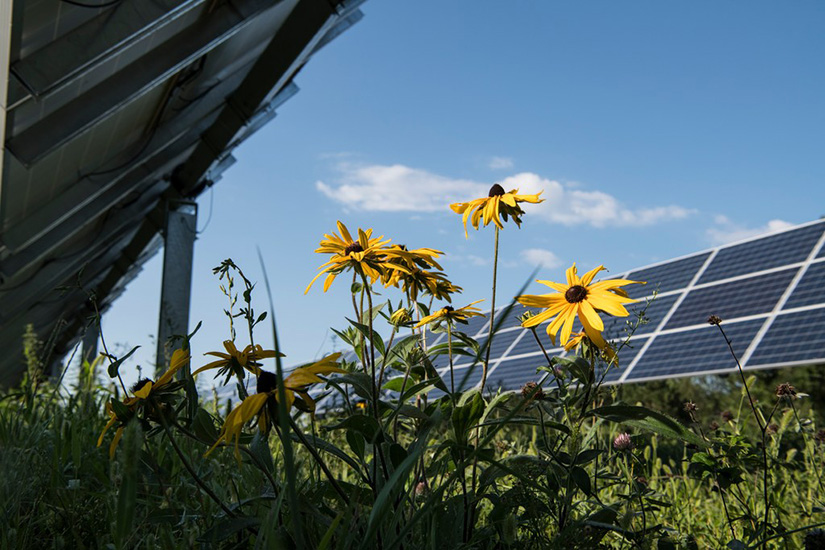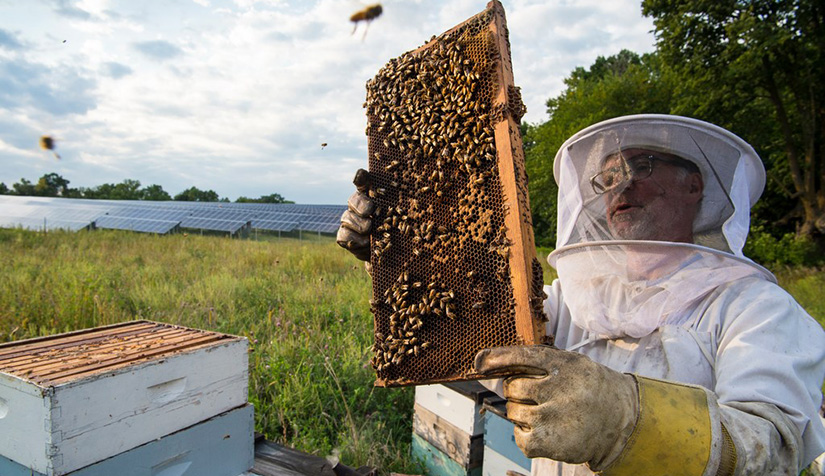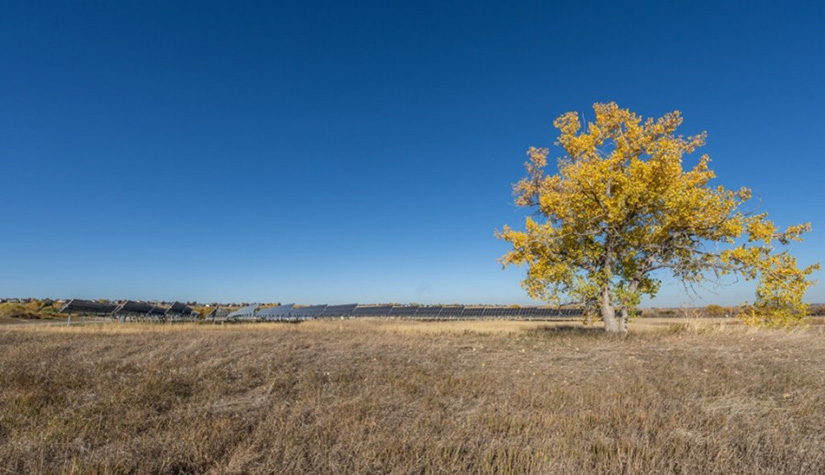Lighting the Way for Agrivoltaics: How NREL Empowers Communities To Capture the Benefits of Solar Energy, Agriculture, and Ecosystems
NREL's Research Helps Farmers, Local Communities, and Global Partners Navigate the Complexities of Bringing Solar Onto the Farm
Nov 21, 2024 | By Sara Fall | Contact media relations
With their reflective, smooth glass sheen, stiff metal posts, and electric wiring, you might be surprised to learn that solar fields can be sites of thriving biodiversity, regenerative agriculture, and community bonding.
Three years ago, when representatives from the U.S. Department of Energy’s National Renewable Energy Laboratory (NREL) first started talking with Josie Hart—a farmer and the associate director of Farm Programs for the Denver Botanic Gardens—she could not have imagined what was possible as a farmer on a solar site.
"I tried to picture a solar field, and I just saw miles of solar panels low to the ground. I didn’t have the best opinion of solar on farm country. For me, as a farmer, it made me so sad to see good productive land go to solar panels," Hart said. "But I learned a lot from NREL researchers about how solar installations can be used to enhance farming and that it’s not just about the solar panels—it’s about the mutual benefits of colocating solar with farming."
Agrivoltaics is the practice of bringing together agricultural activities and photovoltaics (PV)—using the same land to harvest solar energy and reap agricultural benefits, like grazing, crop production, increased pollinator habitat, and soil health.
Grazing
Sheep, cows, or other grazing animals foraging underneath and/or in between solar panels.
Crop Production
Agricultural production under or in between rows of solar panels.
Habitat
Pollinator habitat, native grasses and vegetation, and naturalized beneficial vegetation.
Greenhouse
Solar technologies placed on top of or integrated with greenhouses.
Grazing, crop production, pollinator and native habitat, and greenhouses are the main areas of agrivoltaics researched by NREL. Image from the Innovative Solar Practices Integrated with Rural Economies and Ecosystems (InSPIRE) page on OpenEI
The Denver Botanic Gardens now boasts a new 1.2-MW, 4.5-acre agrivoltaics facility at its Chatfield Farms location, which is a 700-acre native plant refuge and working farm about 20 miles southwest of downtown Denver, Colorado.
“When you walk into the space under the solar panels, the crossbars are 8 feet high. Everything is very high up and spread out, and it’s green and cool and shady. The space is organized, and it feels like an easy place to grow things,” Hart said. “There are sunflowers, a group of mourning doves lives there, and native flowers grow around the exterior. And there’s sainfoin, a cover crop that blossoms early in the year and attracts bees. It’s also a legume, so it helps restore soil. It’s not a sterile space.”
For over nine years, researchers from NREL’s Innovative Solar Practices Integrated with Rural Economies and Ecosystems (InSPIRE) project have been researching the colocation of solar and agriculture as part of research funded through the U.S. Department of Energy Solar Energy Technologies Office.
At first, the challenge was to introduce the concept of agrivoltaics to solar developers, researchers, farmers, and the public and address the question, “Does this really work?” Over time, the challenge was to prove that there can be mutual benefits of bringing together solar and agriculture by conducting research on over 20 agrivoltaics sites. Now, NREL researchers are aiming to refine and adapt the practices of agrivoltaics to meet the specific and varying needs of diverse communities and farms.
Agrivoltaics Is Having a Growth Spurt
In 2020, U.S. agrivoltaics sites encompassed 27,000 acres and produced 4.5 GW of solar energy. By November 2024, U.S. agrivoltaics more than doubled to encompass 60,000 acres and produce 10 GW of solar energy.
Currently there are nearly 600 agrivoltaics sites operating in the United States with grazing, crop production, native and pollinator habitat, greenhouses, and sites that combine these activities.
NREL's InSPIRE project collects and shares data about agrivoltaics activities in the United States on Open Energy Information (OpenEI). InSPIRE's Agrivoltaics Map is sortable by type of agrivoltaics activities, PV technology, and other categories
Jordan Macknick, who leads the InSPIRE project at NREL, said, "People are seeing the benefits of agrivoltaics. Companies are seeing what these benefits are, farmers are seeing what these benefits are, and they're recognizing, 'Hey, this might be for me.' And so they're testing it out. That’s very exciting for agrivoltaics research."
InSPIRE also provides global leadership on agrivoltaics. In July 2024, the project co-hosted the Agrivoltaics World Conference and serves as a lead organization for the International Energy Agency Agrivoltaics Action Group.
The largest category of U.S. agrivoltaics, comprising over 400 sites, is focused on solar colocated with native and pollinator habitat. Over 200 sites bring together solar and grazing for livestock, and smaller fractions of sites pair crop production with solar energy production: 35 produce crops, and three use solar-powered greenhouses. Some sites are counted in multiple categories because they practice more than one use of agrivoltaics.




Clockwise from top left: Native prairie grows beneath solar panels at the Aurora Solar Project in Minnesota. Photo by Dennis Schroeder, NREL; cows graze under solar panels at Jack’s Solar Garden in Colorado. Photo by Joe DelNero, NREL; autumn leaves at the Denver Botanic Gardens agrivoltaics facility (solar installation in the background). Photo by Josh Bauer, NREL; beekeeper Jim Degiovanni inspects hives outside IMS Solar, a pollinator-friendly agrivoltaics site in Minnesota. Photo by Dennis Schroeder, NREL
Collaborating With Communities To Build Opportunity and Security

The Selma High School Green Team visited NREL’s South Table Mountain campus in Golden, Colorado. Photo by James McCall, NREL
Solar deployment can look similar in many places, but every farm is different. NREL helps farmers and others navigate the challenges and complexities of implementing agrivoltaics in small and large farms.
As the Agrivoltaics Community Lead on NREL’s InSPIRE team, energy security researcher and social scientist Dana-Marie Thomas works with communities to help them explore how agrivoltaics can support their goals.
"Many of the communities I work with are BIPOC (Black, Indigenous, and people of color) communities, and they’re not cookie-cutter. They’re all looking for something different because there are different community goals, site-specific conditions, and historical and cultural contexts," Thomas said. "Some communities are looking for energy resilience through incorporating solar plus battery storage, some are looking for educational and workforce development opportunities, and many are interested in legacy building—finding ways to make agriculture innovative and cool for their younger members, to bring them back to the farm."
These communities are facing critical barriers to implementing agrivoltaics, including around lack of knowledge, limited access to funding, systemic inequities in land ownership, and technological challenges.
Thomas worked with members of the Black Farmers' Collaborative in Florida as part of the Clean Energy to Communities Expert Match program. Reverend Jerry G. Nealy of the Black Farmers’ Collaborative wanted to educate his community about solar and agrivoltaics and integrate workforce development into the prison system to reduce recidivism and support skill creation. Cetta Barnhart of Seed Time Harvest Farms, another member of the Black Farmers’ Collaborative, is looking to implement an agritourism component on her farm in Monticello, Florida, similar to Jack’s Solar Garden in Longmont, Colorado.
—Dana-Marie Thomas
Thomas has also engaged with the Selma Center for Nonviolence, Truth, and Reconciliation and Selma High School in Selma, Alabama, who are interested in agrivoltaics workforce development designed to grow students’ awareness of solar job opportunities and pique their interest in farming. They also sought technical assistance for a greenhouse project.
“There’s so much in this agrivoltaics area. In our work at NREL, it’s not just about the technology, it’s not just about the equity; this is about life-saving work for communities,” Thomas said. “By addressing the needs of BIPOC farmers and fostering both innovation and equity, we’re not just transforming energy with agrivoltaics—we’re transforming farming and empowering communities to build a resilient future for generations to come.”
The Potential To Balance the Country’s Clean Energy and Agricultural Needs
InSPIRE members worked with AFT on a DOE Foundational Agrivoltaic Research for Megawatt Scale (FARMS) project led by Rutgers University.
Current AFT members contributed to NREL’s Pathways for Agricultural Decarbonization in the United States and The 5 Cs of Agrivoltaic Success Factors in the United States: Lessons Learned From the InSPIRE Research Study.
Farms and solar farms both gravitate to land that is flat, cleared, well drained, sunny, and close enough to infrastructure to transfer what they produce—energy or food—to the marketplace. Agrivoltaics offers the possibility of protecting food security by using the same land for dual uses rather than converting productive agricultural land to single-use solar fields or other development.
American Farmland Trust (AFT) has been a long-term partner on NREL’s InSPIRE project.
“NREL’s leadership in agrivoltaics helped identify opportunities for farmers early on,” AFT Smart Solar Director Ethan Winter said. “NREL brings technical expertise in all things solar and renewable energy, but it’s not a farming organization. AFT can leverage connections and credibility among farmers to get that research in the hands of farmers.”
—Ethan Winter
AFT works to protect farmland, promote climate-smart farming practices, and develop the next generation of farmers. To Winter, “That’s why solar is so relevant to the AFT mission. Solar on productive farmland should be agrivoltaic solar—and it should include soil health and regenerative applications as well.”
Farmers are looking for ways to keep their farms viable in the face of encroaching urban sprawl and other development, including solar.
Agrivoltaics, Winter said, offers a “farm viability tool.”
“We have an aging demographic in America where the average age of farmers is over 60, and over the next 10 or 15 years, we could see hundreds of millions of acres change hands. And if there’s not a viable farm model, that land could be converted,” Winter said. “With further research, farmer training, supportive policy, we see real opportunities for a next generation of farmers—a diverse pipeline of farmers—who could be working in agrivoltaics.”
NREL Offers Foundational Tools and Resources To Inform Agrivoltaics Decision-Making
Through the InSPIRE project, NREL provides a host of tools and research to inform a growing audience of policymakers, farmers, solar developers, and other researchers.
- For those inspired to dig into the details, the InSPIRE Data Portal is the most comprehensive collection of agrivoltaics research.
- The Agrivoltaics Map catalogs agrivoltaics installations across the United States. This dynamic map is sortable by agrivoltaics activity, PV technology, system size, and type of array.
- The Financial Calculator and modeling tool is a free techno-economic analysis tool designed to facilitate early-stage decision-making about the use of agrivoltaic solar development strategies.
- In partnership with Argonne National Laboratory, NREL has also conducted six years of research into pollinator habitat and its interactions with PV productivity and soil health at the first utility-scale solar-pollinator site in the U.S.
“These tools democratize the evaluation and economic work behind decision-making in agrivoltaics,” said NREL’s Jordan Macknick. “We are aiming to reach the widest possible group of stakeholders out there and empower them to enter into this growing area.”
Collaboration and Goal Setting Are Essential Ingredients for Successful Agrivoltaics Projects
When NREL agrivoltaics researchers work with a partner—a farmer, developer, community, local government, or international client—to determine whether agrivoltaics is a good fit, the first thing they want to know about is the partner’s goals. Then, the NREL researchers introduce a checklist of items that need to be decided with all the stakeholders for a project. Involving farmers and all other stakeholders from the beginning is crucial to establish trust and make sure the project is designed for all parties.
James McCall, an NREL agrivoltaics researcher who provides technical support for communities and others wanting to implement agrivoltaics, said, “There are so many different options for designing an agrivoltaics site, and there isn’t one ‘optimal’ solution that works for everyone. Instead, it’s about translating project goals into the design.”
For example, the Denver Botanic Gardens’ goals for their agrivoltaics facility included:
- Providing food and energy security to 125 low-income households in Denver. These households receive heavily discounted energy, and they will also be the beneficiaries of the produce grown at the solar site.
- Using regenerative farm practices that are more conducive to the increasingly hot and dry climate in Colorado.
- Offering an educational opportunity to visitors.
- Generating 100% of the electricity used at the Botanic Gardens’ Chatfield Farms site.
“We already provide 100 community-supported agriculture (CSA) shares per week to places like a Denver public school that houses teen moms for them to take home and eat fresh vegetables and discover new and interesting veggies,” Josie Hart said. “That’s on top of the 300 CSA shares we provide to subscribers in the community. This agrivoltaics project is an extension of the services we’re already providing to our surrounding communities. That was important to us from the start.”
At each stage of the process, the Botanic Gardens farmers gave input. For example, Josie Hart wanted to ensure that she could drive a full-size John Deere tractor on the site without worrying about knocking over solar panels. At close to five acres, the site is too large to maintain by hand.
One of the toughest obstacles was winning over the neighborhood that lives close to the new solar site, but the neighbors are coming around and getting used to this futuristic approach to farming.
“When we first started talking about this installation in public forums, most people were on board, but we got some detractors once we broke ground,” Hart said. “Now that we’re up and running, we brought our neighbors onto the site, and it was so gratifying to see many of them change their minds once they saw the space. They commented on how nice it was to be under the shade, especially compared to the neighboring field with the sun beating down.
“They recognized that this is farming—it’s not some industrial eyesore, but part of a working farm. Sure, it feels different, maybe, than farms used to feel, but if you’re a farm supporter, you should be all about this.”
Curious about partnering with NREL’s agrivoltaics researchers? Contact Jordan Macknick, James McCall, or Dana-Marie Thomas.

